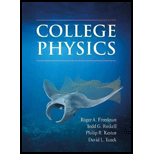
(a)
The magnitude and direction of the impulse given to the ball by the bat, if a baseball bat strikes a ball when both are moving at 31.3 m/s (relative to the ground) toward each other. The bat and ball are in contact for 1.20 ms, after which the ball is traveling at a speed of 42.5 m/s, the mass of the bat and the ball are 850 g and 145 g, respectively?
Answer to Problem 66QAP
The magnitude and direction of the impulse given to the ball by the bat = 10.7 kg m/s along positive x axis.
Explanation of Solution
Given info:
Formula used:
Calculation:
Impulse given to the ball,
Conclusion:
The magnitude and direction of the impulse given to the ball by the bat = 10.7 kg m/s along positive x axis.
(b)
The magnitude and direction of the impulse given to the bat by the ball?
Answer to Problem 66QAP
The magnitude and direction of the impulse given to the bat by the ball = 10.7 kg m/s along negative x axis.
Explanation of Solution
Given info:
Formula used:
Calculation:
By conservation of momentum equation, we have,
Impulse given to the bat,
Conclusion:
The magnitude and direction of the impulse given to the bat by the ball = 10.7 kg m/s along negative x axis.
(c)
What average force does the bat exert on the ball?
Answer to Problem 66QAP
The average force of the bat on the ball is
Explanation of Solution
Given info:
Formula used:
Force,
F = Impulse/Time
Calculation:
Average force,
Conclusion:
The average force of the bat on the ball is
(d)
Why doesn't the force shatter the bat?
Answer to Problem 66QAP
The force value is
Explanation of Solution
Given info:
The average force of the bat on the ball is
Calculation:
The force value is
Conclusion:
The force value is
Want to see more full solutions like this?
Chapter 7 Solutions
COLLEGE PHYSICS
 Physics for Scientists and Engineers with Modern ...PhysicsISBN:9781337553292Author:Raymond A. Serway, John W. JewettPublisher:Cengage Learning
Physics for Scientists and Engineers with Modern ...PhysicsISBN:9781337553292Author:Raymond A. Serway, John W. JewettPublisher:Cengage Learning Physics for Scientists and Engineers: Foundations...PhysicsISBN:9781133939146Author:Katz, Debora M.Publisher:Cengage Learning
Physics for Scientists and Engineers: Foundations...PhysicsISBN:9781133939146Author:Katz, Debora M.Publisher:Cengage Learning Principles of Physics: A Calculus-Based TextPhysicsISBN:9781133104261Author:Raymond A. Serway, John W. JewettPublisher:Cengage Learning
Principles of Physics: A Calculus-Based TextPhysicsISBN:9781133104261Author:Raymond A. Serway, John W. JewettPublisher:Cengage Learning Physics for Scientists and Engineers, Technology ...PhysicsISBN:9781305116399Author:Raymond A. Serway, John W. JewettPublisher:Cengage Learning
Physics for Scientists and Engineers, Technology ...PhysicsISBN:9781305116399Author:Raymond A. Serway, John W. JewettPublisher:Cengage Learning University Physics Volume 1PhysicsISBN:9781938168277Author:William Moebs, Samuel J. Ling, Jeff SannyPublisher:OpenStax - Rice University
University Physics Volume 1PhysicsISBN:9781938168277Author:William Moebs, Samuel J. Ling, Jeff SannyPublisher:OpenStax - Rice University College PhysicsPhysicsISBN:9781285737027Author:Raymond A. Serway, Chris VuillePublisher:Cengage Learning
College PhysicsPhysicsISBN:9781285737027Author:Raymond A. Serway, Chris VuillePublisher:Cengage Learning





